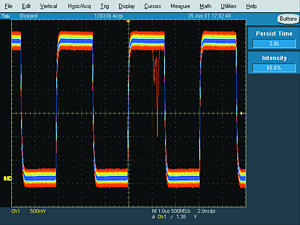
연락처
텍트로닉스 담당자와 실시간 상담 6:00am-4:30pm PST에 이용 가능
전화
전화 문의
9:00am-6:00PM KST에 이용 가능
다운로드
매뉴얼, 데이터 시트, 소프트웨어 등을 다운로드할 수 있습니다.
피드백
TDS5000 Series Digital Phosphor Oscilloscopes - Datasheet
TDS5000 Series Datasheet. (Discontinued. Recommended Replacement: MSO/DPO5000B Series.)
이 데이터 시트의 제품은 텍트로닉스에서 더 이상 판매하지 않습니다.
리퍼브 테스트 장비에 대한 Tektronix Encore를 확인하십시오.
이러한 제품에 대한 지원 및 보증 상태를 살펴보십시오.
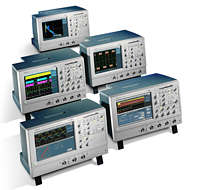
Recommended replacement: MSO/DPO5000B Series.
*
Features & Benefits
- 1 GHz, 500, 350 MHz Bandwidth Models
- 2 and 4 Channel Models
- 5 GS/s Maximum Real-time Sample Rate
- Up to 8 MB Record Length
- 100,000 wfms/s Maximum Waveform Capture Rate
- Intuitive User Interface for Easy Operation
- OpenChoice™ with Windows 2000 Delivers Built-in Networking and Analysis
- Small Footprint
- 10.4 in. (264 mm) Bright Display
- Suite of Advanced Triggers
- Built-in Printer (Optional)
- CD-RW Drive (Optional)
- Interoperability with Tektronix Logic Analyzers
Applications
- Digital Design and Debug
- Investigation of Transient Phenomena
- Power Measurements
- Video Design and Debug
- DVD Analysis
- Disk Drive Analysis
- Jitter and Timing Analysis
- Spectral Analysis
- Automotive Electronics Design and Debug
- Manufacturing Test and Quality Control
- Electro-mechanical Design and Analysis
- Bio-medical Product Development
- Industrial Control
The TDS5000 Series Digital Phosphor Oscilloscopes Deliver High-performance Features At An Unprecedented Price
The TDS5000 Series digital phosphor oscilloscopes (DPO) deliver up to 1 GHz bandwidth, 5 GS/s real-time sample rate, 8 MB record length and 100,000 wfms/s maximum waveform capture rate. This performance, along with a suite of advanced triggers, intuitive user interface, and an open Windows platform, all in a compact bench-top package, provides exceptional value.
DPO
Digital phosphor oscilloscopes provide unmatched insight into signal behavior by displaying, storing and analyzing complex signals in real-time using three dimensions of signal information: amplitude, time and distribution of amplitude over time. The TDS5000 DPO Series delivers fast waveform capture rates, enabled by Tektronix proprietary DPX™ acquisition technology, saving minutes, hours or even days by quickly revealing the nature of faults so sophisticated trigger modes can be applied to isolate them.

Elusive Glitch. Fast waveform capture rate, enabled by Tektronix proprietary DPX acquisition technology, maximizes the probability of capturing elusive glitches and other infrequent events.
Intuitive User Interface
The TDS5000 Series graphical user interface readily adapts to any operating style and environment, making the oscilloscope easy to learn and easy to use. Classic analog-style controls provide instant, front-panel access to the most frequently used functions while the large 10.4 in. (264 mm) display and extensive use of intuitive icons create a highly visual environment with explicit illustration of instrument features. Users can select traditional instrument-style buttons for navigation or switch to a Microsoft Windows menu bar. Waveform positions, cursor locations, and trigger level can be directly changed using a mouse or optional touch screen. A graphical drag-box can be used to select a waveform area for zooming, histogram analysis or measurement gating. The USB interface allows a mouse, keyboard, and other peripherals to be added without powering off the instrument. A context-sensitive help program supplements graphic control windows and encourages users to apply advanced capabilities to solve their problems.
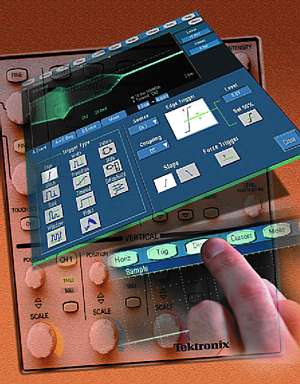
Intuitive User Interface. Whatever your personal preferences, needs or application environment, the TDS5000 Series offers multiple ways to operate the instrument - classic, analog-style knobs, familiar pull-down menus, mouse, and optional touch screen.
OpenChoice Architecture
The TDS5000 Series combines a high performance oscilloscope and a PC in a self-contained unit. With DPX acquisition technology, OpenChoice Windows 2000 desktop, and application programming interfaces (API) for Windows and UNIX, this series provides exceptionally fast data acquisition, analysis, and network accessibility. By using the embedded PCI bus, waveform data can be moved directly from acquisition to analysis applications on the Windows desktop at much faster speeds than conventional GPIB transfers.
In the Tektronix TDS5000 DPO Series, OpenChoice provides a comprehensive software infrastructure for faster, more versatile operations. Data transfer programs, such as the Excel Toolbar or Report Generator, are used to simplify analysis and documentation on the Windows desktop or on external PCs. Tektronix' implementation of industry-standard protocols, such as TekVISA and ActiveX Controls, are included for using and enhancing Windows applications for data analysis and documentation. Or, use the Software Developer’s Kit (SDK) to help create custom software to automate multi-step processes in waveform collection and analysis with Visual BASIC, C, C++, MATLAB, LabVIEW, and other common Application Development Environments (ADE).
Integration of the oscilloscope with external PCs and non-Windows hosts is also supported by the TDS5000 Series software solutions. Plug-and-play and IVI drivers are included to enable easy communication with the oscilloscope using GPIB or LAN connections from LabVIEW and LabWindows programs running on external PCs. UNIX applications, and other LAN resources, can connect directly using the VXI 11.2 server included on the TDS5000 Series.
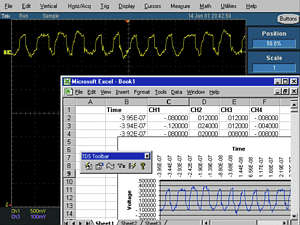
Open Windows Platform. TDS5000 Series waveform display with Excel window and ActiveX toolbar.
Additional Benefits
The TDS5000 Series includes virtually all modern standard interfaces for control and peripheral expansion. An optional built-in printer provides a snapshot and long banner print-outs of waveform and measurement results. An optional CD-RW drive provides convenient and portable mass storage, making data transfer much easier for the user who does not connect the oscilloscope to the network via the standard LAN connection. Interoperability of the TDS5000 Series with Tektronix logic analyzers enables a time-correlated view of analog and digital signals to quickly track down elusive signal integrity problems in designs.
Applications
The TDS5000 Series' high performance features make it ideal for a multitude of applications, such as digital design and debug, power measurements, and video design.
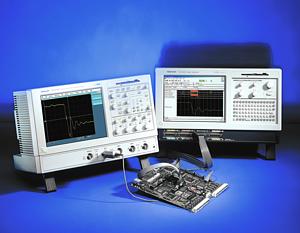
Digital Design and Debug. Tektronix Integrated View (iView) fully integrates the performance and measurement accuracy of a Tektronix oscilloscope with the multi-channel and powerful triggering capabilities of a Tektronix logic analyzer in one display, allowing designers to quickly verify and debug their designs.
Digital Design and Debug
The interoperability of the TDS5000 Series oscilloscope with the Tektronix logic analyzers made possible by Tektronix Integrated View (iView™) enables digital designers to solve signal integrity challenges and effectively debug and verify their systems more quickly and easily. The iView feature fully integrates the industry-leading performance and measurement accuracy of a Tektronix oscilloscope with the multi-channel and powerful triggering capabilities of a Tektronix logic analyzer. This integration allows designers to view time-correlated digital and analog data in the same display window and isolate the analog characteristics of the digital signals that are causing failures in their systems.
The iView Wizard simplifies this integration of the oscilloscope and logic analyzer by guiding the user through set up and connection. No user calibration is required. And, once set up, the iView feature is completely automated. The result - an integrated tool set for digital design and troubleshooting.
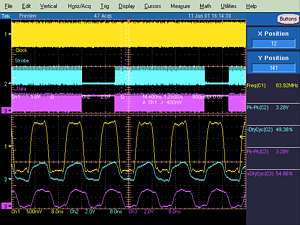
Embedded Design. A source synchronous, double-pumped bus. Channel 1 (yellow) is the clock signal, Channel 2 (blue) is the strobe signal, and Channel 3 (pink) is a data line. The upper half of the graticule shows a long acquisition of a write-cycle, enabling designers to gauge the throughput efficiency of their systems by comparing live writing time with dead time. The bottom half of the graticule shows a zoomed-in view of a small slice of time in the upper graticule, enabling designers to make critical timing measurements to ensure that the data on the bus meets the setup-and-hold timing requirements of the receiver.
Embedded Design
With its long record length, high sample rate, and intuitive zoom model, the TDS5000 Series simplifies the characterization of today's high-speed digital buses, making it an ideal tool for critical timing measurements in embedded design applications.
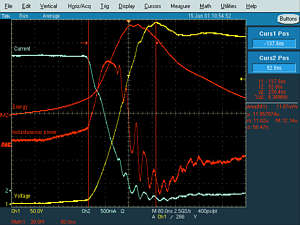
Power Measurements. Channel 1 (yellow, labeled Voltage) shows the turn-off voltage on the FET of a switching power supply, with current on Channel 2 (blue, labeled Current). The Math 1 waveform, M1 (red, labeled Power), is the instantaneous power resulting from the multiplication of the voltage and current waveforms (Ch. 1 * Ch. 2). The Math 2 waveform, M2 (red, labeled Energy), is the result of a calculation of the integral of M1, a math-on-math operation of the TDS5000 Series. An energy measurement, located to the right of the display, is a gated measurement made on M1 and includes statistics. The TDS5000 Series' powerful and flexible measurement, math, and math-on-math capabilities make it an ideal solution for engineers designing today's high-efficiency power devices.
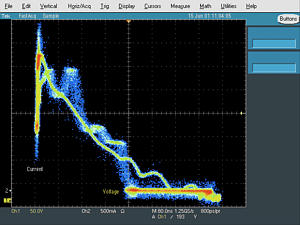
Display of a current vs. voltage trajectory XY plot of the DUT. This highly dynamic waveform display provides continuous coverage of device performance - the waveform data is continuously streamed to the display. Color-grading reveals the distribution of signal activity for comparison against device Safe Operating Area (SOA) characteristics.
Power Measurements
The TDS5000 Series' powerful and flexible measurements, math, and math-on-math capabilities make it an ideal solution for making power measurements, such as voltage, current, instantaneous power, and energy for power device designers.
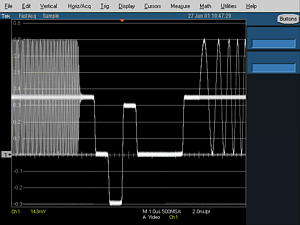
Video Design. Illustration of triggering on an analog HDTV tri-level sync signal and examining horizontal blanking interval.
Video Design
Tektronix exclusive DPX acquisition technology sets the TDS5000 Series apart from other digital oscilloscopes, enabling the capture of up to 100,000 waveforms per seconds for a live, analog-like display. The TDS5000 Series also supports a wide variety of video standards with dedicated triggers including NTSC, PAL, SECAM, and analog HDTV. In addition, IRE and mV graticules can be selected for easier measurements and visual inspection. All of this together makes the TDS5000 Series an ideal tool for video design and development.
Characteristics
Vertical System
| TDS5032/ TDS5034 | TDS5052/ TDS5054 | TDS5104 |
|---|---|---|---|
Input Channels | 2/4 | 2/4 | 4 |
Analog Bandwidth (-3 dB) 5 mV/div - 1 V/div | 350 MHz | 500 MHz | 1 GHz |
Calculated Rise Time 5 mV/div (typical) | 1.15 ns | 800 ps | 300 ps |
Hardware Bandwidth Limits | 150 MHz or 20 MHz | ||
Input Coupling | AC, DC, GND | ||
Input Impedance, 1 MΩ | ±1% | ||
Input Impedance, 50 Ω | ±1% | ±2.5% | |
Input Sensitivity, 1 MΩ | 1 mV/div to 10 V/div | ||
Input Sensitivity, 50 Ω | 1 mV/div to 1 V/div | ||
Vertical Resolution | 8-bits (>11-bits w/ averaging) | ||
Max Input Voltage, 1 MΩ | ±150 V CAT I derate at 20 dB/decade to 9 VRMS above 200 kHz | ||
Max Input Voltage, 50 Ω | 5 VRMS with peaks <±30 V | ||
DC Gain Accuracy | 1.5% with offset set to 0 V | ||
Offset Range, 1 MΩ | 1 mV/div - 99.5 mV/div ±1 V 100 mV/div - 1 V/div ±10 V 1.01 V/div - 10 V/div ±100 V | ||
Offset Range, 50 Ω | 1 mV/div - 99.5 mV/div ±1 V 100 mV/div -1 V/div ±10 V | 1 mV - 50 mV/div ±0.5 V 50.5 mV - 99.5 mV ±0.25 V 100 mV - 500 mV ±5 V 505 mV - 1 V/div ±2.5 V | |
Channel-to-channel Isolation Any Two Channels at Equal Vertical Scale | ≥100:1 at ≤100 MHz and ≥30:1 at >100 MHz up to the rated bandwidth | ||
Timebase System
| All Models |
|---|---|
Timebase Range | 200 ps/div to 40 s/div |
Timebase Delay Time Range | 16 ns to 250 s |
Channel-to-channel Deskew Range | ±75 ns |
Delta Time Measurement Accuracy | ±(0.30 sample interval) + (15 ppm * reading) |
Trigger Jitter (RMS) | 8 psRMS (typical) |
Long Term Sample Rate and Delay Time Accuracy | ±15 ppm over ≥1 ms interval |
Acquisition System
| 2 Ch Models (TDS5032/5052) | 4 Ch Models (TDS5034/5054/5104) |
|---|---|---|
Real-time Sample Rates | ||
1 Channel (max) | 5 GS/s | |
2 Channels (max) | 2.5 GS/s | |
3-4 Channels (max) | -- | 1.25 GS/s |
Equivalent Time Sample Rate (max) | 250 GS/s | |
Maximum Record Length per Channel with Standard Memory | 400 k (1 ch) 200 k (2 ch) | 400 k (1 ch), 200 k (2 ch), 100 k (4 ch) |
With Opt. 1M | 2 M (1 ch), 1 M (2 ch) | 2 M (1 ch), 1 M (2 ch), 500 k (4 ch) |
With Opt. 2M | 8 M (1 ch), 4 M (2 ch) | 8 M (1 ch), 4 M (2 ch), 2 M (4 ch) |
Maximum Duration at Highest Real-time Resolution (1 ch)
| All Models |
|---|---|
Time Resolution (single shot) | 200 ps (5 GS/s) |
Max Duration with Standard Memory | 80 μs |
Max Duration with Opt. 1M | 400 μs |
Max Duration with Opt. 2M | 1.6 ms |
Acquisition Modes
| All Models |
|---|---|
FastAcq Acquisition | FastAcq optimizes the instrument for analysis of dynamic signals and capture of infrequent events |
Maximum FastAcq Waveform Capture Rate | 100,000 wfms/s |
Sample | Acquire sampled values |
Peak Detect | Captures narrow glitches at all real-time sampling rates |
Minimum Peak Detect Pulse Width | <1 ns |
Averaging | From 2 to 10,000 waveforms included in average |
Envelope | From 2 to 2 x 109 waveforms included in min-max envelope |
Hi-Res | Real-time boxcar averaging reduces random noise and increases resolution |
FastFrame™ Acquisition | Acquisition memory divided into segments; maximum trigger rate >225,000 waveforms per second. |
Trigger System
| All Models |
|---|---|
Sensitivity | |
Internal DC Coupled | 0.35 div DC to 50 MHz increasing to 1 div at rated bandwidth |
External (auxiliary input) | 400 mV from DC to 50 MHz increasing to 750 mV at 100 MHz |
Main Trigger Modes | Auto, Normal, and Single |
Trigger Sequences | Main, Delayed by time, Delayed by events. All sequences can include separate horizontal delay after the trigger event to position the acquisition window in time |
Trigger Level Range | |
Internal | ±10 divisions from center of screen |
External (auxiliary in) | ±8 V |
Line | Fixed at 0 V |
Trigger Coupling | DC, AC (attenuate <60 Hz), HF reject (attenuate >30 kHz) LF reject (attenuates <80 kHz) Noise reject (reduce sensitivity) |
Trigger Holdoff Range | 250 ns minimum to 12 s maximum |
Trigger Modes
Edge - Positive or negative slope on any channel or front panel auxiliary input. Coupling includes DC, AC, noise reject, HF reject, and LF reject.
Video - Trigger on NTSC, PAL, SECAM, analog HDTV, and non-standard video formats.
Glitch - Trigger on or reject glitches of positive, negative or either polarity. Minimum glitch width is 1.0 ns with 200 ps resolution.
Width - Trigger on width of positive or negative pulse either within or out of selectable time limits ranging from 1 ns to 1 s with 200 ps resolution.
Runt - Trigger on a pulse that crosses one threshold but fails to cross a second threshold before crossing the first again. Event can be time or logic qualified (logic on 4 channel models only).
Window - Trigger on an event that enters or exits a window defined by two user-adjustable thresholds. Event can be time or logic qualified (logic on 4 channel models only).
Timeout - Trigger on an event which remains high, low or either, for a specified time period, selectable from 1 ns to 1 s with 200 ps resolution.
Transition - Trigger on pulse edge rates that are faster or slower than specified. Slope may be positive, negative or either.
Setup/Hold - Trigger on violations of both setup time and hold time between clock and data present on any two input channels.
Pattern - Trigger when pattern goes false or stays true for specified period of time. Pattern (AND, OR, NAND, NOR) specified for four input channels defined as High, Low or Don't Care.
State - Any logical pattern of channels (1, 2, 3) clocked by edge on channel 4 (channel 2 on TDS5052). Trigger on rising or falling clock edge.
Trigger Delay by Time - 16 ns to 250 seconds.
Trigger Delay by Events - 1 to 10,000,000 Events.
Waveform Measurements
Amplitude - Amplitude, High, Low, Maximum, Minimum, Peak to Peak, Mean, Cycle Mean, RMS, Cycle RMS, Positive Overshoot, Negative Overshoot.
Time - Rise Time, Fall Time, Positive Width, Negative Width, Positive Duty Cycle, Negative Duty Cycle, Period, Frequency, Delay.
Combination - Area, Cycle Area, Phase, Burst Width.
Histogram-related (optional) - Waveform count, Hits in box, Peak hits, Median, Maximum, Minimum, Peak to Peak, Mean (μs), Standard Deviation (sigma), μ+1 (σ), μ+2 (σ), μ+3 (σ).
Waveform Processing/Math
Standard Math
Arithmetic - Add, subtract, multiply, and divide waveforms.
FFT - Magnitude.
Vertical Units - Magnitude: Linear, dB, dBm.
Window Functions - Rectangular, Hamming, Hanning, Kaiser-Bessel, Blackman-Harris, Gaussian, Flattop2, Tek Exponential.
Optional Math
Algebraic Expressions - Define extensive algebraic expressions including waveforms, scalars, and results of parametric measurements e.g. (Integral (Ch1-Mean(Ch1))*1.414).
Calculus - Integrate, differentiate.
Frequency Domain Functions - Spectral magnitude and phase, real and imaginary spectra.
Additional Vertical Units - Phase: degrees, radians.
Display Characteristics
Display Type - Liquid crystal active-matrix color display.
Display Size - 211.2 mm (W) x 158.4 mm (H), 264 mm (10.4 in) diagonal.
Display Resolution - 640 horizontal x 480 vertical pixels.
Waveform Styles - Vectors, Dots, Intensified Samples, Variable Persistence, Infinite Persistence.
Computer System and Peripherals
CPU - Intel Celeron Processor, 1.2 GHz.
PC System Memory - 256 MB.
Hard Disk Drive - ≥20 GB capacity.
Floppy Disk Drive - Front panel 3.5 in floppy disk drive, 1.44 MB capacity.
CD-ROM Drive - Side panel CD-ROM drive.
CD-RW Drive (Optional) - Side panel CD-RW drive.
Printer (Optional) - Built-in thermal printer.
Mouse - Logitech thumb wheel model included, USB interface.
Keyboard - Order 119-6633-00 (USB interface).
OpenChoice Software
TekVISA - Application Programmers Interface (API) for Windows developers. Documentation includes descriptions and samples of programming test and measurement applications on the unit in Visual BASIC, C and C++.
TekVisa Control (TVC) - Active controls to make access to TekVISA easy for integration into Microsoft Windows applications.
VXI-11 server - An Application Programmers Interface (API) for LAN connectivity from a variety of external host computers.
For information regarding TDS5000 Series compatibility with National Instruments hardware and software products, contact your local Tektronix account manager.
For information about using a TDS5000 Series oscilloscope as a GPIB controller, contact your local Tektronix account manager.
Plug-and-play Drivers - Provides support to run National Instrument's LabVIEW and LabWindows on an external PC connected to a TDS5000 Series oscilloscope.
IVI Drivers - Provides support for new and existing program environments utilizing the IVI instrumentation standard, such as LabVIEW, LabWindows/CVI, MATLAB, Visual BASIC, and C/C++.
Excel Toolbar - Provides direct access to waveforms and measurements on the oscilloscope from a toolbar in Excel.
Report Generator - Enables the ability to design and create customized report templates that extract the oscilloscope's waveforms, settings, measurements, and other on-screen information with a click of the mouse.
LabVIEW and MATLAB - 30 day evaluation copies plus non-expiring demo programs that perform a variety of LabVIEW and MATLAB display and analysis functions with the oscilloscope.
Software Developer’s Kit (SDK) - a CD is included in the Getting Started With OpenChoice™ book. This SDK includes a wealth of documentation, programming tools, and examples to assist programmers working with the TDS5000 Series.
Input/Output Ports
Auxiliary Input - Front panel BNC connector. Trigger level range is adjustable from +8 V to -8 V. The maximum input voltage is ±20 V.
Probe Compensator Output - Front panel pins. Amplitude 1 V ± 1% into a ≥10 kΩ load, frequency 1 kHz ±5%.
Analog Signal Output Amplitude - Rear-panel BNC connector, provides a buffered version of the signal that is attached to the Channel 3 input. 20 mV/div ±20% into a 1 MΩ load, 10 mV/div ±20% into a 50 Ω load (4 channel models only).
Analog Signal Output Bandwidth, Typical - 100 MHz into a 50 Ω load (4 channel models only).
Auxiliary Output Levels - Rear-panel BNC connector, provides a TTL-compatible, negative polarity pulse when the oscilloscope triggers.
External Reference In - Rear-panel BNC connector. 9.8 MHz to 10.2 MHz.
Parallel Port - IEEE 1284, DB-25 connector.
Audio Ports - Miniature phone jacks for stereo microphone input and stereo line output.
USB Port - Allows connection or disconnection of USB keyboard and/or mouse while oscilloscope power is on.
Keyboard Port - PS-2 compatible.
Mouse Port - PS-2 compatible.
LAN Port - RJ-45 connector, supports 10Base-T and 100Base-T.
Serial Port - DB-9 COM1 port.
SVGA Video Port - DB-15 female connector; connect a second monitor to use dual-monitor display mode. Supports basic requirements of PC99 specifications.
GPIB Port - IEEE 488.2 standard.
Scope VGA Video Port - DB-15 female connector, 31.6 kHz sync, EIA RS-343A compliant, connect to show the oscilloscope display, including live waveforms on an external monitor or projector.
Power Source
Power - 100 to 240 VRMS ±10%, 47 to 63 Hz; CAT II, <220 W.
Physical Characteristics
Benchtop Configuration | ||
|---|---|---|
Dimensions | mm | in. |
Weight | kg | lbs. |
Rackmount Configuration | ||
Dimensions | mm | in. |
Weight | kg | lbs. |
Mechanical | ||
Dimensions | mm | in. |
Height | 285 | 11.2 |
Width | 447 | 17.6 |
Depth | 288 | 11.35 |
Net | 10.55 | 23.25 |
Shipping | 25 | 55 |
Height | 267 | 10.5 |
Width | 483 | 19 |
Depth | 288 | 11.35 |
Net | 11.8 | 26 |
Kit | 5 | 11 |
Cooling - Required Clearance for Benchtop Configuration | ||
Top | 0 | 0 |
Bottom | 0 | 0 |
Left Side | 76 | 3 |
Right Side | 0 | 0 |
Front | 0 | 0 |
Rear | 0 | 0 |
Environmental
Temperature
Operating - +5 °C to +45 °C.
Nonoperating - -20 °C to +60 °C without diskette in floppy drive.
Humidity
Operating - 20% to 80% relative humidity with a maximum wet bulb temperature of +29 °C at or below +50 °C, noncondensing. Upper limit derated to 25% relative humidity at +50 °C.
Nonoperating - With no diskette in floppy disk drive. 5% to 90% relative humidity with a maximum wet bulb temperature of +29 °C at or below +60 °C, noncondensing. Upper limit derated to 20% relative humidity at +60 °C.
Altitude
Operating - 10,000 ft. (3,048 m).
Nonoperating - 40,000 ft. (12,190 m).
Random Vibration
Operating - 0.1 GRMS from 5 to 500 Hz, 10 minutes each axis, 3-axes, 30 minutes total.
Nonoperating - 2.0 GRMS from 5 to 500 Hz, 10 minutes each axis, 3-axes, 30 minutes total.
Electromagnetic Compatibility - 89/336/EEC.
Safety - UL 3111-1, CSA-22.2 No. 1010.1, EN61010-1, IEC61010-1/A2.
Ordering Information
TDS5032 - 350 MHz, 2 channel digital phosphor oscilloscope.
TDS5034 - 350 MHz, 4 channel digital phosphor oscilloscope.
TDS5052 - 500 MHz, 2 channel digital phosphor oscilloscope.
TDS5054 - 500 MHz, 4 channel digital phosphor oscilloscope.
TDS5104 - 1 GHz, 4 channel digital phosphor oscilloscope.
All models include: One P5050 500 MHz, 10x Passive Probe per Channel, Front Cover (200-4651-00), Mouse (119-6298-00), Quick Reference (020-2398-00), GPIB Programmer's Reference, TDS5000 Series Product Software CD-ROM, TDS5000 Series Operating System Restoration CD-ROM, Getting Started with OpenChoice™ book, and Software Developer’s Kit CD (020-2513-00), Performance Verification Procedure PDF file, Calibration Certificate Documenting NIST Traceability, Z540-1 Compliance, and ISO9001 Registration, Power Cord.
Please specify power plug and manual version when ordering.
Power Plug Options
Opt. A0 - North America power.
Opt. A1 - Universal EURO power.
Opt. A2 - United Kingdom power.
Opt. A3 - Australia power.
Opt. A5 - Switzerland power.
Opt. A10 - China power.
Opt. A99 - No power cord or AC adapter.
Recommended Accessories
Keyboard (USB interface) - Order 119-6633-00.
Service Manual - Order 071-1004-xx.
Transit Case - Order 016-1937-00.
Scope Cart - Order K420 and 436-0317-00 (mouse accessory tray).
Video Display Clamp - Order 013-0278-xx.
Thermal Printer Paper - Order 016-1897-00.
Instrument Options (Available where indicated by 'x')
| TDS5032 | TDS5034 | TDS5052 | TDS5054 | TDS5104 | |
|---|---|---|---|---|---|---|
Hardware Options | ||||||
Acquisition Memory Options | ||||||
Mounting Options | ||||||
Software Options | ||||||
Bundle Options | ||||||
Probe Options | ||||||
Manual Options | ||||||
Service | ||||||
16 | CD-RW drive | x | x | x | x | x |
17 | Additional 256 MB of RAM | x | x | x | x | x |
18 | Touch-screen interface | x | x | x | x | x |
1P | Built-in thermal printer | x | x | x | x | x |
1M | 2 Msamples max (1 ch) | x | x | x | x | x |
2M | 8 Msamples max (1 ch) | x | x | x | x | x |
1K | K420 oscilloscope cart | x | x | x | x | x |
1R | Rackmount kit | x | x | x | x | x |
2A | Advanced analysis - equation editor, spectral FFT, and histograms | x | x | x | x | x |
J2 | TDSDDM2 - Disk drive measurements software |
|
| x | x | x |
JT3 | TDSJIT3 - Jitter and timing analysis software |
| x |
| x | x |
J3E | TDSJIT3E – Jitter and timing analysis software essentials |
| x |
| x | x |
DVD | TDSDVD - Optical storage analysis software | x | x | x | x | x |
PW2 | TDSPWR2 - Power measurements software | x | x | x | x | x |
USB | TDSUSBS - USB2.0 compliance test software only |
| x |
| x | x |
TSY | Includes options 16, 17, 18, 1P, 2A, and 2M | x | x | x | x | x |
33 | Add (1) P6158 3.0 GHz, 20x low C probe |
|
|
|
| x |
34 | Add (1) P6247 1.0 GHz differential probe | x | x | x | x |
|
35 | Add (1) P6243 1.0 GHz active probe | x | x | x | x |
|
37 | Add (1) P6245 1.5 GHz active probe |
|
|
|
| x |
39 | Add (1) P6248 1.7 GHz differential probe |
|
|
|
| x |
53 | Add (1) P5050 500 MHz, 10x passive probe | x | x | x | x | x |
L0 | English User Manual | x | x | x | x | x |
L5 | Japanese User Manual | x | x | x | x | x |
L10 | Russian User Manual | x | x | x | x | x |
Opt. C3 | Calibration Service 3 Years | x | x | x | x | x |
Opt. C5 | Calibration Service 5 Years | x | x | x | x | x |
Opt. D1 | Calibration Data Report | x | x | x | x | x |
Opt. D3 | Calibration Data Report 3 Years (with Option C3) | x | x | x | x | x |
Opt. D5 | Calibration Data Report 5 Years (with Option C5) | x | x | x | x | x |
Opt. R3 | Repair Service 3 Years | x | x | x | x | x |
Instrument Upgrades
Upgrades equivalent to original options can be ordered to extend instrument performance after initial purchase. Users can install most upgrades without opening the instrument case or requiring on-site service (except for Options 16, 18, MU, and CPU). Order a TDS5UP and the appropriate option(s) listed below.
TDS5UP Upgrade Kit (Kit requires at least one option)
Opt. 16 - Upgrade from CD-ROM to CD-RW.
Opt. 18 - Upgrade to touch screen.
Opt. 1P - Upgrade to integrated thermal printer.
Opt. M01 - Upgrade memory depth from standard to Opt. 1M.
Opt. M02 - Upgrade memory depth from standard to Opt. 2M.
Opt. M12 - Upgrade memory depth from Opt. 1M to Opt. 2M.
Opt. MU - Add 256 MB of PC RAM.
Opt. 2A - Advanced analysis - equation editor, spectral FFT, and histograms.
Opt. JT3 - TDSJIT3 - Jitter and timing analysis software with Rj/Dj and BER.
Opt. J3E - TDSJIT3E - Jitter and timing analysis software essentials.
Opt. J23 - Upgrade TDSJIT2 jitter and timing analysis software to TDSJIT3.
Opt. J2E - Upgrade TDSJIT2 jitter and timing analysis software to TDSJIT3E.
Opt. J2 - TDSDDM2 - Disk drive measurements software.
Opt. DVD - TDSDVD - Optical storage analysis software.
Opt. PW2 - TDSPWR2 - Power measurements software.
Opt. USB - TDSUSBS - USB 2.0 Compliance test software.
Opt. CPU - Upgrade motherboard and processor.
Opt. W2K - Upgrade from Windows Me to Windows 2000.
Opt. IF - Factory installation of selected options.



